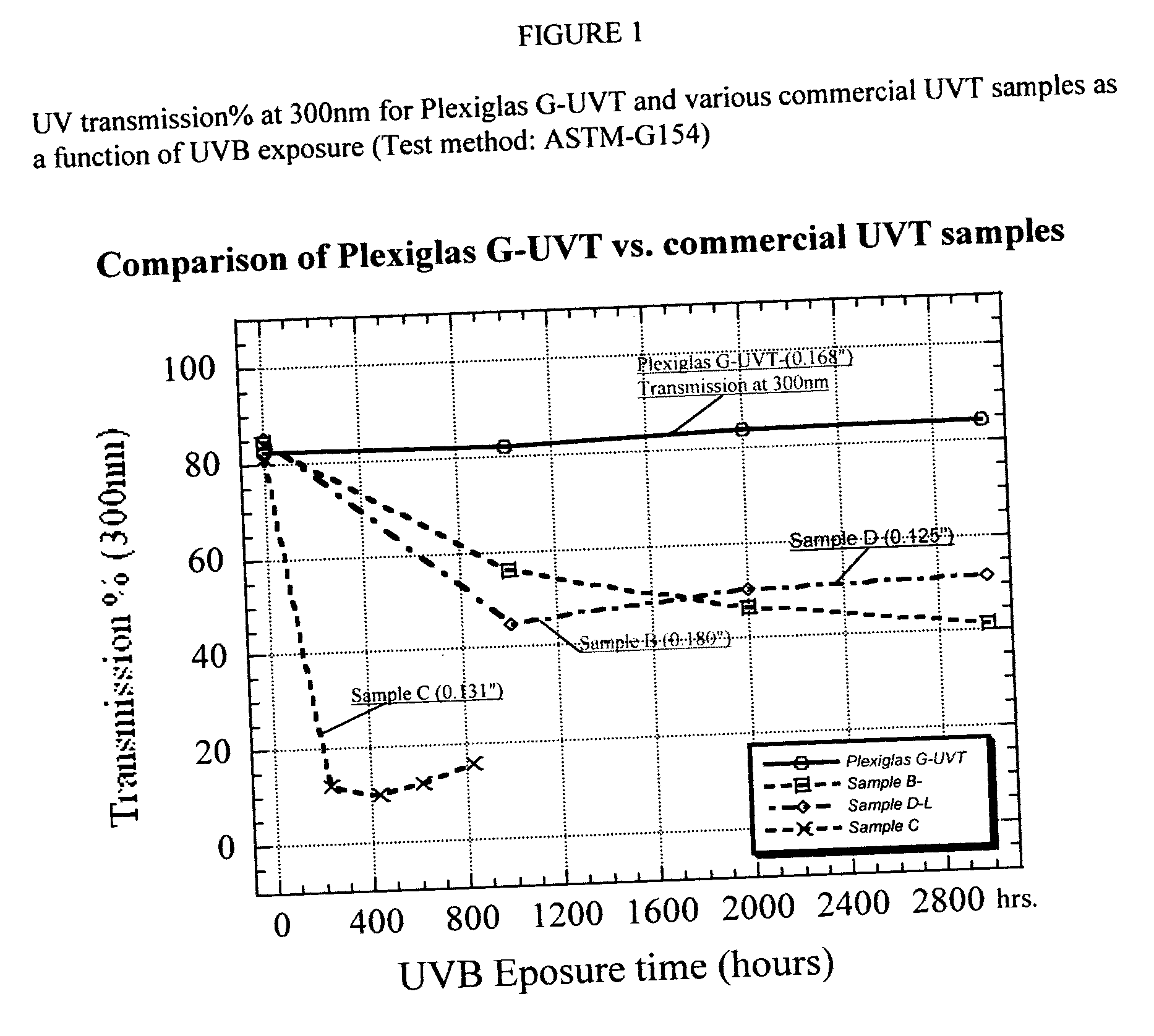Stabilized UV transparent acrylic composition
a technology of transparent acrylic and stabilized uv, which is applied in the direction of layered products, synthetic resin layered products, chemistry apparatus and processes, etc., can solve the problems of shortening the service life of commercial uv transparent acrylic sheets, difficult to retain high uv transparency and clarity under strong uv radiation, etc., and achieves resistance to deterioration and high uv transmission.
- Summary
- Abstract
- Description
- Claims
- Application Information
AI Technical Summary
Benefits of technology
Problems solved by technology
Method used
Image
Examples
examples 1-4
[0039] The preparation procedures for the examples 1, 2, 3 and 4 are as following: 100 g of MMA monomer was added into four separate clean containers, 0.1 g of stearic acid, 0.03 g of 2,2 Azobisisobutyronitrile, 0.04 g of Lupero®-70 were also added into each container. Lactic acid having a high purity was added 0.5 g for example 1, 0.75 g for example 2, 1.0 g for example 3. 1.0 g of butyl lactate (comparative) was added for example 4. The monomer mixture in each container was mixed thoroughly on a laboratory shaker. At least 15 minutes mixing time was provided before filling the glass cell.
[0040] The monomer mix from each container was then filled into glass cell sealed with a PVC spacer between the glass plates. The vacuum was applied to each container to remove air bubbles before and after filling the glass cells. Oxygen has been found to hinder the polymerization. The glass cell assemblies were placed into a water bath at 61° C. for about 9 hours; the glass cells were then trans...
examples 8-10 (comparative)
[0043] The samples of example 8, 9, and 10 were made by similar procedures as disclosed in example 1. The compositions of 100.0 g of methyl methacrylate monomer, 0.10 g of stearic is 5 acid, 0.03 g of Luperoxg-11, 0.04 g of Lupero®-70 were prepared in three separate clean containers and mixed thoroughly on a laboratory shaker. To each of the containers, 0.5 g (as example 8), 1.0 g (as example 9), and 10.2 g (as example 10) of acetic acid were added and mixed by a shaker. The monomer mixtures were then heated at 61° C. for 9 hours, 82° C. for 4 hours, and 125° C. for 3 hours. The samples were then exposed to a Q-UVB Accelerated Weathering Tester of Q-Panel Lab Products using UVB 313EL type lamp. The UV transmission at 300-nm and yellowness index number was measured every 200-hours intervals. The results were listed in the following table. The example 10 which contains about 1.2% acetic acid, showed some effect on UV stabilization. The results are shown in Table 3 below. ...
examples 11-15
Mixtures of Lactic Acid and Hindered Amine Light Stabilizers (HALS)
[0044] The combination of lactic acid and Tinuvin® 770, a hindered amine light stabilizer (HALS), also showed good resistance to yellowing and UV radiation. However, the HALS alone even at a relatively high concentration could not provide protection for UV radiation, as revealed in example 13, 14, and 15. The example 11 contains 90% methyl methacrylate, 10% methyl acrylate, 0.10% stearic acid, 0.03% Luperox®11, 0.04% Luperox®70, 0.5% lactic acid, and 0.015% Tinuvin®-770. The example 12 contains 90% MMA, 10% MA, 0.10% stearic acid, 0.03% Luperox®-11, 0.04% Luperox-70, 0.5% lactic acid, and 0.025% Tinuvin®-770. Although HALS is useful together with lactic acid, it could not provide effective protection by itself for the acrylic sample under UVB radiation. The example 13 contains 90% MMA, 10% MA, 0.10% stearic acid, 0.03% Luperox®11, 0.04% Luperox®70, and 0.3% Tinuvin 770 on a weight basis. The examples 14 and 15 conta...
PUM
| Property | Measurement | Unit |
|---|---|---|
| temperature | aaaaa | aaaaa |
| wavelength | aaaaa | aaaaa |
| weight percent | aaaaa | aaaaa |
Abstract
Description
Claims
Application Information
 Login to View More
Login to View More - R&D
- Intellectual Property
- Life Sciences
- Materials
- Tech Scout
- Unparalleled Data Quality
- Higher Quality Content
- 60% Fewer Hallucinations
Browse by: Latest US Patents, China's latest patents, Technical Efficacy Thesaurus, Application Domain, Technology Topic, Popular Technical Reports.
© 2025 PatSnap. All rights reserved.Legal|Privacy policy|Modern Slavery Act Transparency Statement|Sitemap|About US| Contact US: help@patsnap.com

